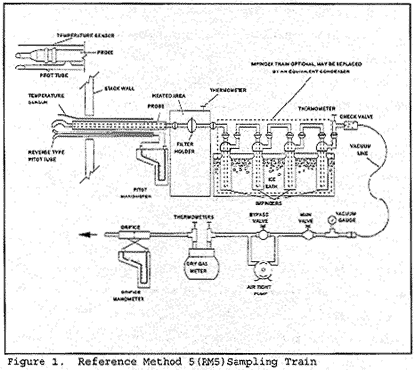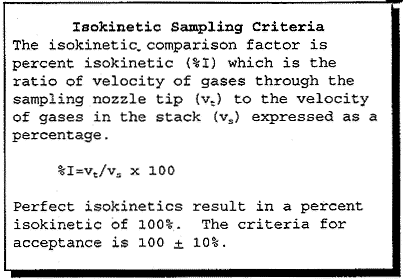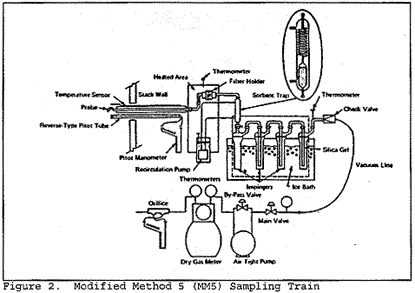Primer on stack-emissions testing — Part 2: Sampling methods

Particulate testing must be isokinetic. This means that the sample must have been drawn at approximately the same velocity as the natural air velocity in the stack.
The first installment (Part 1) of this series mostly covered the reasons favoring the use of stack testing. Continuing on, this part explores the popular methods in use and the means to use them properly.
Particulate Sampling
The workhorse of stack sampling methods is known as EPA Reference Method 5 (RM5). This method for measuring particulates is required for almost all source-emission tests.
Figure 1 is a schematic of the RM5 train. The train comprises a heated sample probe with stainless steel nozzle and liner, pitot tube, a heated box with a filter holder and filter, four "impingers" (two with 100-ml water, one empty, and one with silica gel), a vacuum line, a pump, dry-gas meter, and calibrated orifice.
The filter is weighed under controlled temperature and moisture conditions to a constant weight before the test. During the test, as a gas sample is drawn through the train, particulates are removed by the filter. The volume of sample is determined from the dry gas meter that has been calibrated before the test against a wet-test meter. Moisture content of the gas—required to ascertain concentrations in dry volume—is determined by weighing the various impingers before and after the test.
The filter is collected and again weighed under controlled conditions to a constant weight. The difference in weights gives the total particulate weight captured by the filter. In addition, any particulates in the probe are recovered and weighed. The weights of particulates in the probe and filter are combined for a total particulate weight. Knowing the weight of particulate captured and the volume of the sample, allows calculation of the concentration of particulates in the stack gases. If needed, a particulate emission rate (usually in lbs/hr) can be readily calculated by multiplying the concentration by the stack-gas flow rate.

Testing for particulates usually is conducted for one hour. The RM5 requires that a minimum of 30 dry standard cubic feet (dscf) be collected. Each separate test event is referred to as a run.
It is important to remember that the method requires three separate runs for any given operating condition. All three runs must be valid, based upon method QA criteria such as sampling-train leak rates. Also particulate testing must be isokinetic. This means that the sample must have been drawn at approximately the same velocity as the natural air velocity in the stack (see box).

Failure to meet the isokinetic criteria will generally be grounds for rejecting the run. Fortunately, these determinations can be made on site and repeat testing can be conducted as necessary.
Reference Method 5 must be used in conjunction with other methods, and, in particular, with Reference Method I (RMI).
RMI specifies the location of sampling ports in the stack. For the most common situation, a round stack, two sampling ports are required to be set 90 degrees apart on the stack. (Different guidelines apply to a rectangular stack/duct.) Proper location of the ports is necessary to compensate for potential upstream and downstream flow disturbances.
The sampling probe is inserted through the ports into the stack, and sampling is conducted at various locations along the diameter of the stack. The number of sampling points is also dictated by RMI. After the traverse is completed at one port, the probe is withdrawn and the same process is repeated at the other port. This procedure ensures the withdrawal of a representative sample from the stack.
Semi-volatile organic Compound Sampling
The Modified Method 5 (MM5) train, or SW846 Method 0010, often is used in testing hazardous-waste incinerators. It is designed to capture semi-volatile organic compounds (compounds that have a boiling point in excess of 100°C).
As can be seen from its schematic in Figure 2, MM5 is quite similar to the RM5 train, and the operating procedures are identical in many ways. A key difference in the train, however, is the addition of a condenser and sorbent trap containing XAD-2 resin between the filter and the impingers.

During testing, the sample is drawn through the train where the filter captures particulates, and gaseous components continue to the condenser where they cool. The gases along with condensed moisture (and possibly condensed organics) pass through the resin cartridge.
The condensate collects in the empty impinger that follows. The train may capture the organic target compound in the particulate catch, the resin, or in the condensate from the resin. The particulates (filter and probe wash), the resin, and the condensate are all extracted with methylene chloride. The methylene chloride is reduced in volume and generally analyzed using a GC/MS.
Since the organic compound may be found in the particulate phase or adsorbed onto the particulates, sampling must be performed isokinetically. As with most stack-sampling methods, three successful runs are necessary for any tested condition. Unlike particulate sampling, each run with the MM5 will last a minimum of three hours, and at least 105 dscf of sample must be collected.
Other Methods
Numerous other stack-testing methods may be encountered, including those following.
Continuous monitors. Gaseous pollutants often are measured using continuous monitors rather than capturing a discrete sample for later analysis. This method is limited by the requirement that an EPA approved instrument be available for the pollutant of interest. It is applicable to carbon monoxide, sulfur dioxide, oxides of nitrogen, oxygen (as an operating parameter rather than a pollutant), opacity, and a few other pollutants.
Continuous monitors have the distinct advantage of providing a continuous readout of real time concentrations throughout the test period rather than an average. This is particularly useful in trying to determine reasons for exceeding standards. Furthermore, sampling for gases does not require that isokinetic criteria be met, so single point (no traversing or changing of sample ports) sampling is permitted. A major disadvantage is the need to calibrate the monitors on site with costly calibration gases.
Flask/canister collection. Other applications use a steel canister or glass flask as the collection device for gaseous sampling. The device is evacuated and sampling is conducted by inserting a probe into the stack and opening the valve on the evacuated container. The container then goes to the lab for direct analysis. This method can be used for NOx and certain VOCs.
Other methods are simple variations on the RM5 train and differ primarily in the impinger solutions and in the sample-recovery methods. Some of the most common examples of pollutants for which they apply are metals and SO2.
The next installment covers the value of quality assurance.
About the author: David L. Daughdrill is program manager, Air Pollution Source Management, U.S. Army Center for Health Promotion and Preventive Medicine, Aberdeen Proving Ground Edgewood Area, Maryland. Tel: 1-800-222-9698. (Back to top)
The previous article was adapted from "Primer on Air Pollution Emission Testing," presented by David L. Daughdrill at the Proceedings from the 1996 Real World Air Conference, Colorado Springs, CO, Sept. 3 to 6, 1996.
